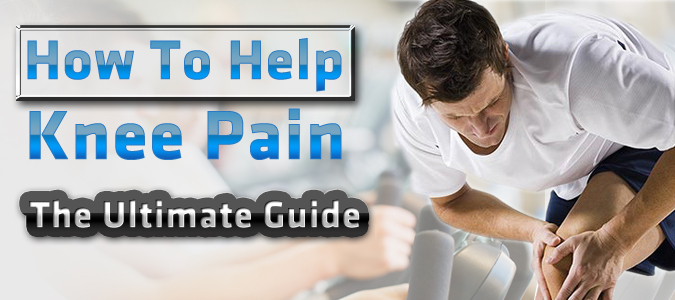
Knee pain can and will affect many of us at some stage in our lives. The great news is, if your knee pain stems from an overuse injury then there are a number of general things you can do to help reduce the pain significantly. The tough thing about knee pain is that once damage has been ruled out, your diagnosis will almost always be of the chronic variety. Patellar Tendonitis, Mistracking etc etc. The fact of the matter is that it’s a bit of a stab in the dark. We will talk a little more about those common problems, but today we’ll get straight some some easy solutions.
What Is Wrong With Most Knee Rehabilitation Programs?
Too often they focus on the knee itself. As obvious as it may seem, this usually will not give you the relief you need and is not the cause of the problem. To have a healthy knee as a general rule you will need to have good mobility in the hip and the ankle, a strong knee joint, and have correct biomechanics when moving.
You may have heard about the VMO and it’s role in helping knee pain. That you need to activate the VMO preferentially and get it stronger in order to avoid knee pain. Sure, you may have some imbalances in the knee. but new research has shown that this might not be the case and activating this muscle by itself is extremely difficult.
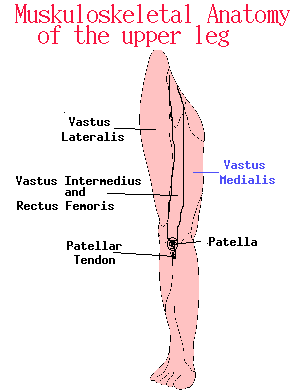
Often you need to look elsewhere other than the root of the pain to find solutions. Think about patella tendonitis. The tendon is usually inflamed and overused, the tendon attaches to the quads, holy crap we best be fixing those quads then… right? Nope. Why would you do even more quad dominated exercises, try to fix imbalances around the knee if the problem is actually an overuse of the knee? Surely there are some biomechanics issues and weaknesses going on in surrounding joints, putting a whole lot of pressure onto the tendon.
If your hip or your ankle is malfunctioning, tight, immobile or weak you are automatically going to put pressure up or down the chain. Your knee is a significant part of that chain and it is often forced to do a lot more work than necessary.
So How Can I Help My Knee Pain?
Realise that everything that comes next is a general rule to help reduce chronic knee pain, and most of it comes from my own experience. As a volleyball player my knees take a beating, and these things without fail help to reduce my pain every day. Try them all and see what works for you, where you are lacking, and what you need the most.
Strengthen/ Activate
Lets forget the quads for a bit here, sure some of you may suffer from an ‘imbalance’ in the VMO and laterals quads, but I’m pretty sure you suffer from weak or inactive glutes as well. Realise that the glutes themselves may be strong, you just have an inability to get them to fire and activate, and use your quads instead.
People with knee pain often have poor hip control. The knee ends up doing a lot of work that in reality the hip should be doing. In order to take the pressure off the knees it is imperative that you get your glutes strong and functioning. The bridge is a great exercise to start with, do 3 sets of 15 on each leg, I promise you that will be hard. Start double legged if you need.

Check out this video on glute activation I made a while ago.
Last but not least here are 8 exercises that really engage your glutes. Enjoy.
Honestly, weak and inactive glutes are a huge contributor to knee pain, and an easy fix. The stronger your glutes are the less your knees are going to have to work.
Calf strength has recently come into play, and Aussie physic Jill Cook has done a lot of research into calf raises and how they can help reduce knee pain in general. Try to add in a couple of sets of body weight calf raises overtime you head to the gym, do a workout or a training session. Strong calves again mean less pressure through the knee, as they do a lot of work in take off and landing and do a lot of work absorbing eccentric forces.
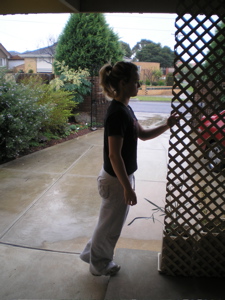
Stretch
Stretching the right places is imperative, as we have discussed before. Stretching the wrong places can sometimes hinder your objective. One place that it is absolutely certain you need to stretch, are the hip flexors. One of the major hip flexors is the Rec Fem. It’s the muscle that attaches from your hip right onto your tendon, it is the most superficial muscle of the quads.
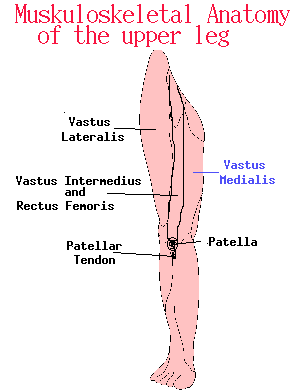
It can often get tight and cause a whole lot of knee pain. So stretch the hip flexors in general. Tight hip flexors will also result in a bum that is not as active, thanks to reciprocal inhibition. Stretch them, tight hip flexors suck and cause a lot of issues.
Self Soft Tissue Work
What is even better than stretching? Soft tissue work. Obviously the best thing you can do is go and get a professional to work out your kinks, but thankfully there is a much cheaper solution, and one that works pretty well. I am constantly using a foam roller and tennis ball/ massage ball to help relieve a lot of my knee pain. Here are the two I use…the thera roll is a crazy invention, hurts like nothing else, but really does give you a good myofascial release. It is better than your average foam roller, but to take it one step further, you should get on the tennis or massage ball.
Key parts to work on should be the…
Rec Fem
It is really important to give your rec fem an absolute beating. Roll it out to start, focus us and down the muscle, but eventually get onto the tennis ball, it will really help your knee pain. Pics and videos to follow, in the meantime lay face down, place the foam roller or tennis ball directly under the middle of your qauds, and move up and down. If you find a sensitive area, or trigger point, start flexing the knee.
Hip Flexors

Glutes
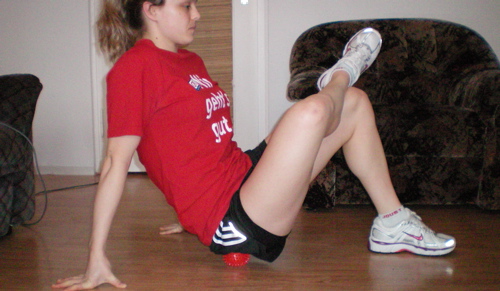
TFL
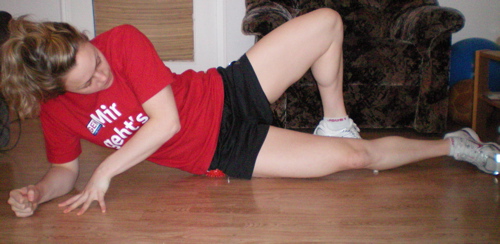
ITB

All these places, especially the Rec Fem, have the tendency to be tight and overused and with a little releasing will go a long way to relieving your knee pain. Tight glutes transmit onto the TFL and the ITB, a lot of stress on the ITB is a big cause of knee pain. Lets address all of these areas with some soft tissue work. You can see above the pics on how to use a massage or tennis ball, check out this video as well on using a foam roller. Remember that the thera roll gets in a little deeper.
For a complete how to guide on releasing your body, check out The Ultimate Self Massage Guide.
Mobility
Having mobile joints above and below the knee are imperative to knee health. The ankle and the hip need to be mobile and moving correctly in order for your knee to function optimally and take the stress off it.
Here are some videos on exactly how to get that mobility through your ankle and hip.
Ankle
Hip
Check out this hip mobility guide at Volleyball Base.
Here are some more vids to help you.
Like I said guys, all of these things may not work for everyone, and most of them I have come across through experimentation. I help my own pain by continually applying these principles. Try it out, I have no doubt you will be able to reduce your knee pain significantly.
If you like this post and suffer from muscle and joint pain, then you need to check out the Ultimate Self Massage Guide. It details exactly how to release all the important muscles in your body with a tennis ball and foam roller. This knowledge will enable you to treat your own pain at home, get rid of your symptoms without spending money on a therapist, and move and feel better.
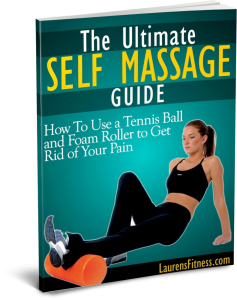
Adero says
Hello,
A friend of mine referred me to your site. I’m so glad she did. Thank you for the information. I am going to give these a try.
On another note, I wanted to let you know that you have a typo in the section on Rec Fem. You’ve written “Roll it out to start, focus us and down the muscle,…” however the word after focus should be up instead of us.
You’ve offered such amazing information and advice!
Thank you again
Lauren says
Thanks Adero!